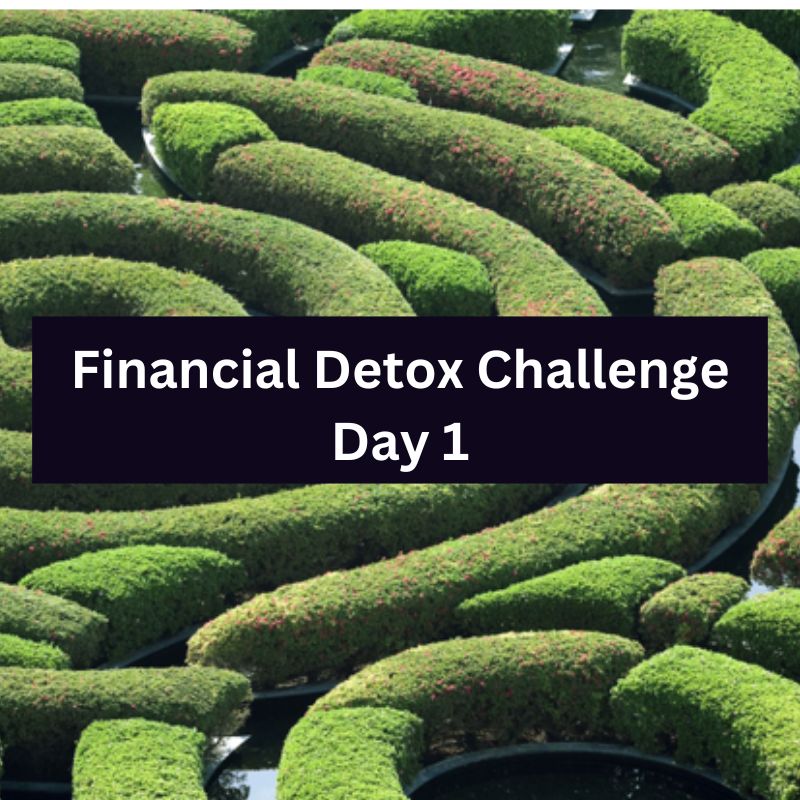Day 1 Uncover Hidden Spending
A downloadable challenge that includes daily emails with tasks designed to help you identify wasteful spending, understand your financial habits, and start thinking about savings.
Welcome to “The 7-Day Financial Detox Challenge,” designed specifically for women over 55 who want to enhance their cash flow and achieve financial peace of mind.
This week-long journey will guide you through simple yet powerful daily tasks to help you identify wasteful spending, understand your financial habits, and kickstart your savings journey.
Plus, you’ll get exclusive access to our supportive Facebook group for ongoing peer support.
Let’s get started!
Each email in this 7-day challenge will include a detailed explanation of the day’s task, the rationale behind it, and tips for success. Participants will be encouraged to share their progress in the Facebook group and support one another, creating a sense of community and accountability.
The goal of this challenge is not just to teach financial skills but also to foster a supportive network that makes the journey towards financial health a shared, collective experience.
Day 1: Uncover Hidden Spending
Task: Review last month’s bank statements. Highlight any expense that wasn’t essential.
Goal: Identify one area where you can cut back this month.
Objectives: Guide you through the process of reviewing your bank statements, identify non-essential spending and prioritising expenses to make smarter financial decisions.
Today, we’re beginning a journey that many find eye-opening. It’s Day 1 of our ‘7-Day Financial Detox Challenge,’ and we’re going to uncover the hidden spending that’s often overlooked in our daily lives.”
Let’s dive into our bank statements and discover how to spot those sneaky expenses that can derail our savings goals.”
Learning Point 1: Understanding Your Statement
Firstly, let’s delve into the intricacies of our bank statements. Beyond being mere records of transactions, they unfold a compelling story of our spending habits and financial choices. As we navigate through the statement, pay close attention to the withdrawals section. Yes, it captures the predictable stream of regular bills, but it also unveils the subtleties of those seemingly inconspicuous expenditures that, when accumulated, wield a significant impact on our financial landscape. Each entry tells a story, providing valuable insights into the patterns and tendencies that shape our financial journey.
Instructions
Take your most recent statement — you can get it online, through your bank’s app, or a paper copy if you prefer the old-school method. Start by reviewing each transaction.
Does it look familiar? Is it a need or a want?”
Learning Point 2: Spotting Non-Essential Expenses
Our second point emphasises the importance of discerning between needs and wants in your spending habits.
Take a closer look at your daily routines – that habitual visit to the coffee shop may provide momentary pleasure, but do you truly need it?
Consider the subscription services you’ve accumulated over time – are they genuinely enhancing your life or quietly draining your resources?
The gym membership, once a regular expense, might now be redundant as you’ve embraced the simplicity of daily walks in the park.
By identifying and reassessing these non-essential expenditures, you open up opportunities to redirect those funds towards meaningful and impactful financial goals, such as building your emergency fund for lasting peace of mind.”
Instructions
Highlight every expense that isn’t essential for your well-being or happiness. Be honest with yourself — if it’s not adding value to your life, it’s a potential savings opportunity.
Learning Point 3: Prioritising Your Expenses
Finally, let’s prioritise. Some expenses are non-negotiable, like housing and groceries. But others? They’re negotiable. This is where we find our hidden gems of savings.
Take a moment to distinguish between essential and discretionary expenses. Essential expenses are the necessities of life – the roof over your head, the food on your table.
These are the non-negotiables that form the foundation of your budget. On the other hand, discretionary expenses are the choices we make – the extra cup of coffee, the occasional dining out, or the impulse purchases.
Now, let’s zero in on those discretionary expenses. Are there areas where you can cut back without sacrificing your well-being or happiness?
Maybe it’s finding more affordable alternatives, exploring discounts, or simply being more mindful of your spending habits.
By prioritising what truly matters and trimming down on non-essential expenses, you’ll uncover valuable opportunities to save and build your emergency fund with confidence.
Instructions
Create two columns: ‘Needs’ and ‘Wants.’ Assign each non-essential expense to the appropriate column. This visual will help you decide where to trim the fat.
Now, armed with your highlighted statement and your needs vs. wants list, identify one area where you can cut back. That’s your task for today, and it’s a powerful first step in our challenge.”
Join me tomorrow for Day 2, and remember to share your progress in our Facebook group. Let’s support each other in uncovering hidden spending and boosting our emergency funds.
And if you haven’t yet, don’t forget to download your bank’s app or check out their online platform for easy access to your statements. It’s all about convenience and clarity.
Call to Action
Drop a comment below or in our group about the one area you’re cutting back on this month. We’re in this together, building a future of financial security and peace of mind.

